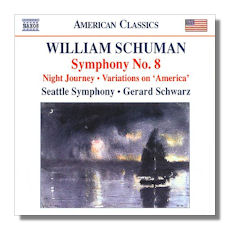
The Internet's Premier Classical Music Source
Related Links
-
Ives Reviews
Schuman Reviews - Latest Reviews
- More Reviews
-
By Composer
-
Collections
DVD & Blu-ray
Books
Concert Reviews
Articles/Interviews
Software
Audio
Search Amazon
Recommended Links
Site News
 CD Review
CD Review
American Classics

- William Schuman:
- Symphony #8
- Night Journey
- Charles Ives: Variations on America (arr. William Schuman)
Seattle Symphony Orchestra/Gerard Schwarz
Naxos 8.559651
William Schuman (1910-92) had the misfortune of bearing a surname almost identical to that of the better-known German composer Robert Schumann. I well remember from decades ago seeing Schuman LPs filed under "Schumann" at record stores, and to this day the American's recordings are no doubt still placed in the Schumann bins by less-discerning clerks. But of course Schuman deserves better treatment.
His works list includes eight symphonies – Nos. 3 through 10, the first two having been withdrawn. The Third is probably the most popular, while the Eighth (1962) here is among the least performed and recorded. At slightly over a half-hour, it is an austere work, fairly dissonant and quite dark in mood. It isn't as difficult for the listener, however, as the composer's penultimate symphony, the Ninth, subtitled The Ardeatine Caves. For its time, in fact, the Eighth is not particularly advanced in its expressive language.
The first movement Lento sostenuto comes across as a tense lamentation. Following an insistent series of sustained chords in the opening, the horn spins out a dour melody, imparting a bitter and hardly consolatory mood. The whole movement remains tense, especially in the faster music that comes in the second half.
The second movement Largo isn't any brighter, and the expressive character of the music remains deep and profound. The presto finale ushers in more coloration, at least in instrumentation and rhythmic activity, but the music cannot shirk the clinging darkness and tension. The piano, xylophone, glockenspiel and vibraphone try to brighten things, as do some playful winds, but to little avail. In the end, one views the music as close in character to that of fellow American Peter Mennin in his mostly dark and dead-serious symphonies.
Night Journey, subtitled a Choreographic Poem for Fifteen Instruments, is derived from Schuman's ballet Night Journey (1947), his most successful theater work. This scaled-down version – really a transcription without repeats – from 1981, exhibits a slowly-paced nocturnal character in the opening, which eventually gives way to menacing strings and piano. Later on the mood brightens, so to speak, amid much rhythmic activity and deftly-fashioned instrumentation, although the nocturnal character remains throughout the piece. Lasting 25:28 in this performance, this work is certainly worthwhile, and perhaps the strongest piece here.
The Ives arrangement is a nice filler of seven minutes duration. Finally the mood substantially brightens in this light celebratory piece. It is an arrangement of the Ives original for organ, which features variations on My Country 'Tis of Thee. It's a delightful, often humorous work that goes against the grain on this disc of otherwise serious music.
Gerard Schwarz draws convincing performances in all works from the Seattle Symphony Orchestra and the sound Naxos provides is excellent. Recommended to fans of Schuman and 20th century American music in general.
Copyright © 2010, Robert Cummings




















